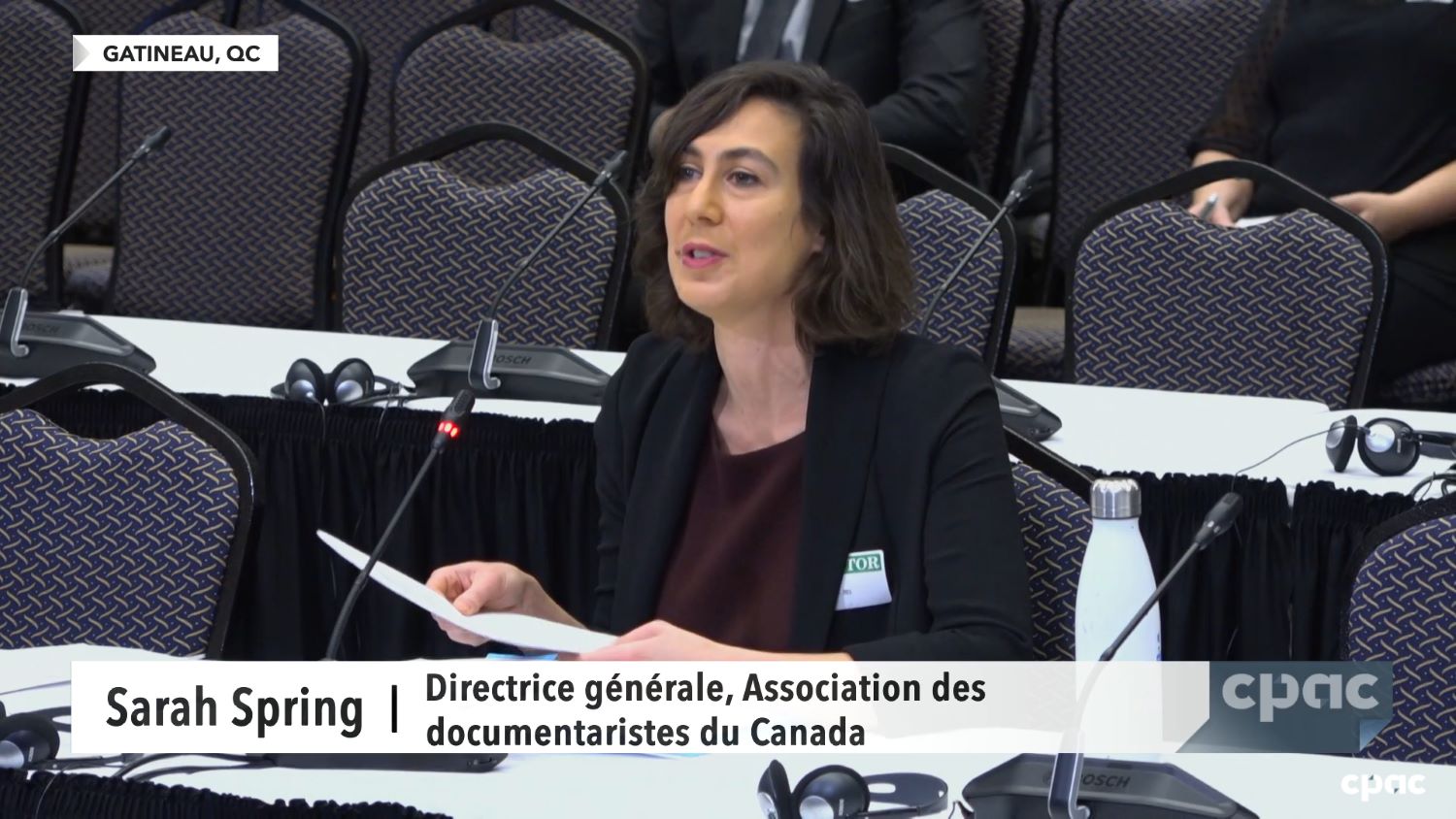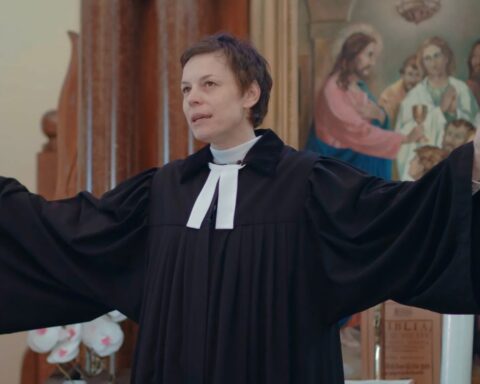On Friday, December 8, Documentary Organization of Canada (DOC) executive director Sarah Spring presented at the CRTC hearing The Path Forward – Working towards a modernized regulatory framework regarding contributions to support Canadian and Indigenous content. We are sharing her opening marks below:
—
Good morning. My name is Sarah Spring, and I am the Executive Director of the Documentary Organization of Canada. We represent 1300 documentarians across the country, and for forty years, DOC’s mission has been to ensure that Canada’s documentary creators are able to thrive within an equitable, accessible and sustainable sector. As both the Director of DOC and a former documentary producer myself, I am proud to be speaking to you today on behalf of Canada’s documentary community.
First of all, I would like to commend the Commission for the sense of invitation that has infused this entire hearing. It has been moving and inspiring to hear from respected colleagues from across the country, including many voices that are appearing before the CRTC for the first time. I am truly honoured to be here on the last day of this historic proceeding.
We are here to speak about key issues from the perspective of documentaries. In particular, to advocate for a modernized framework that includes support for Canadian and Indigenous documentary content, and for measures that will lead to structural changes that prioritize Indigenous sovereignty, and equity across our sector.
Long form documentaries are a vital component of Canada’s cultural, political, social and economic fabric
Canada is known as a leader in documentary filmmaking. In March, Canadian filmmaker Daniel Roher’s Navalny took home the Oscar for best documentary. And in August, for the second year in a row, Telefilm put forth a documentary [Rojek] to represent Canada’s best film at the Academy Awards.
Our projects have incredible reach, and a lasting impact on public discourse. John Grierson, who founded the National Film Board, spoke of documentaries as a key tool to understand, to see and to care about the changes that are transforming our society. Documentaries are part of Canada’s cultural fabric, and have been for over sixty years.
Among the more than a dozen intervenors who have spoken about the importance of documentaries, the CMF [Canada Media Fund] called it a critical genre that is at once very successful and fragile. The DGC and Telefilm pointed to the fundamental role that documentaries play in the Canadian sector, and the ARRQ [Association des réalisateurs et réalisatrices du Québec] mentioned the crisis in funding for feature documentary films.
Documentaries are a gateway
As was also referenced by the Rogers Group of Funds, documentaries are a gateway into the sector, where creators grow their skills and their careers. Before Sarah Polley’s Women Talking, came the documentary Stories We Tell. Tracey Deer’s first feature was the 2005 documentary Mohawk Girls, about her community of Kahnawake. And ten years before Shasha Nakhai made her breakout feature Scarborough, she directed the personal documentary The Sugar Bowl.
Documentary is a gateway for those who face historic barriers. Many of the intervenors who have spoken before the commission to advocate for equity within the new framework began their careers in documentary, and have gone on to be leaders in the sector.
Documentary is a gateway to relearning Canada’s history. Indigenous filmmakers are making seminal documentaries that are fundamental to our collective process of reconciliation, from Alanis Obomsawin to Tasha Hubbard to Alethea Arnaquq-Baril.
Decreasing support for Canadian and Indigenous long-form documentaries within the Canadian broadcasting system
However, we have a problem. Despite the many successes and the importance of this genre of content, there has been a significant drop in support for long-form documentaries.
DOC commissioned a study from Nordicity that was published in September, that we will be pleased to file with the Commission, that shows that while audiences for our home-grown documentaries continue to grow, the type of long-form documentaries that are so important to our cultural expression are at risk. Support for documentaries that can be expensive to produce, take a long time to make, tell our important stories, and which the CRTC moved to protect when they defined the genre in 2010 – are decreasing every year.
Our study shows that the vast majority, over 80% of documentary production in Canada is now lower budget documentary series. Now while there is of course a role for this type of market-driven content in our ecosystem, it is also critical that long-form, author-driven documentary content also continues to have an important presence. This content requires regulation.
If we have an imbalance in the stories we tell, we face a crisis in which we are not meeting our cultural objectives. So this is where regulation is so important.
A modern framework must include support for long-form documentaries
A modernized regulatory framework that includes minimum requirements for these crucial long-form documentary productions is consistent with key public policy objectives of the Broadcasting Act and the Policy direction, which points to the importance of a diversity of genres, in its instructions to the Commission to support a wide range of Canadian programming and Canadian creators.
We recommend that 20% of a base contribution be mandated for spending on feature films, with half of this for fiction work and half for feature documentaries. We recognize that this is a bold proposal, but we are in unprecedented times. This urgent contribution is absolutely necessary to ensuring that these stories persevere.
Supporting documentaries ensures a diversity of programming, a diversity of voices, a diversity of stories, and a living library of Canadian perspectives. This is reasonable, equitable and appropriate.
A commitment to sovereignty, equity, accessibility and anti-racism must be at the foundation of the CRTC’s regulatory framework
Both the Broadcasting Act and the Policy Direction point to a historic shift in our sector that offers the possibility of meaningful, structural change toward narrative sovereignty and towards equity. These commitments must be at the foundation of the CRTC’s regulatory framework.
Supporting Indigenous narrative sovereignty is essential to our screen sector. Indigenous content is a key pillar of our broadcasting system. DOC supports mandatory funding from the base contribution to the ISO [Indigenous Screen Office].
DOC supports the proposal that the CRTC mandate 35% for creators from equity-deserving communities, and we support direct funding to the CISF [Canadian Independent Screen Fund] and BSO [Black Screen Office].
We also support the proposal by the DSO [Disability Screen Office] that the CRTC mandate alignment with the 2019 Accessibility Canada Act and that Funds be obligated to Identify, remove and prevent barriers to accessibility.
DOC’s position on other key elements of a modernized regulatory framework
We echo many of our colleagues and also recommend:
- A 5% base contribution as part of a larger framework;
- That the public-private split should be 80-20;
- That new contributions to public funds be split 60-40 English to French;
- And finally, that the CRTC support the BPF and BAF.
Thank you for your time and your consideration.














